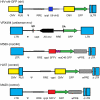Survival of the fittest: positive selection of CD4+ T cells expressing a membrane-bound fusion inhibitor following HIV-1 infection
- PMID: 20808813
- PMCID: PMC2925957
- DOI: 10.1371/journal.pone.0012357
Survival of the fittest: positive selection of CD4+ T cells expressing a membrane-bound fusion inhibitor following HIV-1 infection
Abstract
Although a variety of genetic strategies have been developed to inhibit HIV replication, few direct comparisons of the efficacy of these inhibitors have been carried out. Moreover, most studies have not examined whether genetic inhibitors are able to induce a survival advantage that results in an expansion of genetically-modified cells following HIV infection. We evaluated the efficacy of three leading genetic strategies to inhibit HIV replication: 1) an HIV-1 tat/rev-specific small hairpin (sh) RNA; 2) an RNA antisense gene specific for the HIV-1 envelope; and 3) a viral entry inhibitor, maC46. In stably transduced cell lines selected such that >95% of cells expressed the genetic inhibitor, the RNA antisense envelope and viral entry inhibitor maC46 provided the strongest inhibition of HIV-1 replication. However, when mixed populations of transduced and untransduced cells were challenged with HIV-1, the maC46 fusion inhibitor resulted in highly efficient positive selection of transduced cells, an effect that was evident even in mixed populations containing as few as 1% maC46-expressing cells. The selective advantage of the maC46 fusion inhibitor was also observed in HIV-1-infected cultures of primary T lymphocytes as well as in HIV-1-infected humanized mice. These results demonstrate robust inhibition of HIV replication with the fusion inhibitor maC46 and the antisense Env inhibitor, and importantly, a survival advantage of cells expressing the maC46 fusion inhibitor both in vitro and in vivo. Evaluation of the ability of genetic inhibitors of HIV-1 replication to confer a survival advantage on genetically-modified cells provides unique information not provided by standard techniques that may be important in the in vivo efficacy of these genes.
Conflict of interest statement
Figures






Similar articles
-
A Membrane-Anchored Short-Peptide Fusion Inhibitor Fully Protects Target Cells from Infections of Human Immunodeficiency Virus Type 1 (HIV-1), HIV-2, and Simian Immunodeficiency Virus.J Virol. 2019 Oct 29;93(22):e01177-19. doi: 10.1128/JVI.01177-19. Print 2019 Nov 15. J Virol. 2019. PMID: 31462566 Free PMC article.
-
Efficient entry inhibition of human and nonhuman primate immunodeficiency virus by cell surface-expressed gp41-derived peptides.Gene Ther. 2008 Sep;15(17):1210-22. doi: 10.1038/gt.2008.73. Epub 2008 May 1. Gene Ther. 2008. PMID: 18449216 Free PMC article.
-
Glycosylphosphatidylinositol-Anchored Anti-HIV scFv Efficiently Protects CD4 T Cells from HIV-1 Infection and Deletion in hu-PBL Mice.J Virol. 2017 Jan 18;91(3):e01389-16. doi: 10.1128/JVI.01389-16. Print 2017 Feb 1. J Virol. 2017. PMID: 27881659 Free PMC article.
-
[The current progress in the development of HIV-1 fusion inhibitors].Yao Xue Xue Bao. 2010 Feb;45(2):184-93. Yao Xue Xue Bao. 2010. PMID: 21351428 Review. Chinese.
-
Is there a future for antiviral fusion inhibitors?Curr Opin Virol. 2012 Feb;2(1):50-9. doi: 10.1016/j.coviro.2012.01.002. Epub 2012 Jan 28. Curr Opin Virol. 2012. PMID: 22440966 Review.
Cited by
-
Creating genetic resistance to HIV.Curr Opin Immunol. 2012 Oct;24(5):625-32. doi: 10.1016/j.coi.2012.08.013. Epub 2012 Sep 15. Curr Opin Immunol. 2012. PMID: 22985479 Free PMC article. Review.
-
Mechanistic Models Predict Efficacy of CCR5-Deficient Stem Cell Transplants in HIV Patient Populations.CPT Pharmacometrics Syst Pharmacol. 2016 Feb;5(2):82-90. doi: 10.1002/psp4.12059. Epub 2016 Feb 16. CPT Pharmacometrics Syst Pharmacol. 2016. PMID: 26933519 Free PMC article.
-
Stem cell-based anti-HIV gene therapy.Virology. 2011 Mar 15;411(2):260-72. doi: 10.1016/j.virol.2010.12.039. Epub 2011 Jan 17. Virology. 2011. PMID: 21247612 Free PMC article. Review.
-
The utility of the new generation of humanized mice to study HIV-1 infection: transmission, prevention, pathogenesis, and treatment.Retrovirology. 2011 Aug 11;8:65. doi: 10.1186/1742-4690-8-65. Retrovirology. 2011. PMID: 21835012 Free PMC article. Review.
-
Gene transfer of two entry inhibitors protects CD4⁺ T cell from HIV-1 infection in humanized mice.Gene Ther. 2016 Feb;23(2):144-50. doi: 10.1038/gt.2015.101. Epub 2015 Oct 21. Gene Ther. 2016. PMID: 26488891
References
-
- Sterne JA, Hernan MA, Ledergerber B, Tilling K, Weber R, et al. Long-term effectiveness of potent antiretroviral therapy in preventing AIDS and death: a prospective cohort study. Lancet. 2005;366:378–384. - PubMed
-
- Kozal MJ. Drug-resistant human immunodefiency virus. Clin Microbiol Infect. 2009;15(Suppl 1):69–73. - PubMed
-
- Patel AK, Patel KK. Future implications: compliance and failure with antiretroviral treatment. J Postgrad Med. 2006;52:197–200. - PubMed
-
- Braun SE, Johnson RP. Setting the stage for bench-to-bedside movement of anti-HIV RNA inhibitors-gene therapy for AIDS in macaques. Front Biosci. 2006;11:838–851. - PubMed
Publication types
MeSH terms
Substances
Grants and funding
LinkOut - more resources
Full Text Sources
Other Literature Sources
Medical
Research Materials

